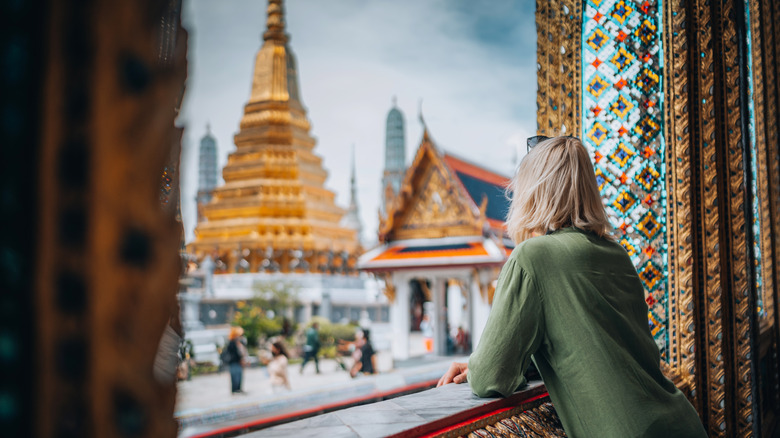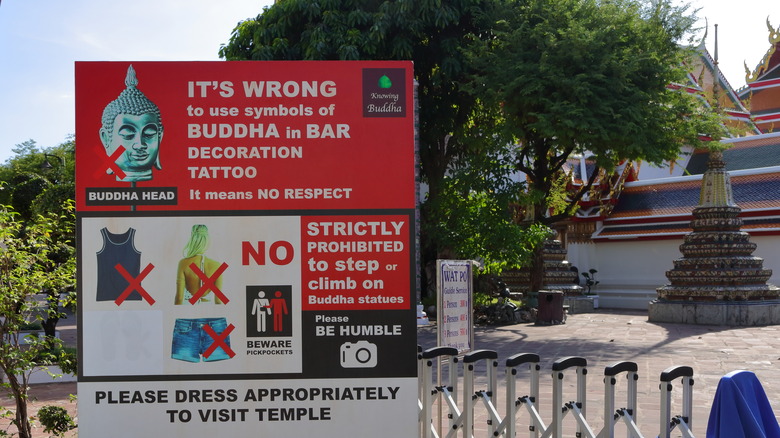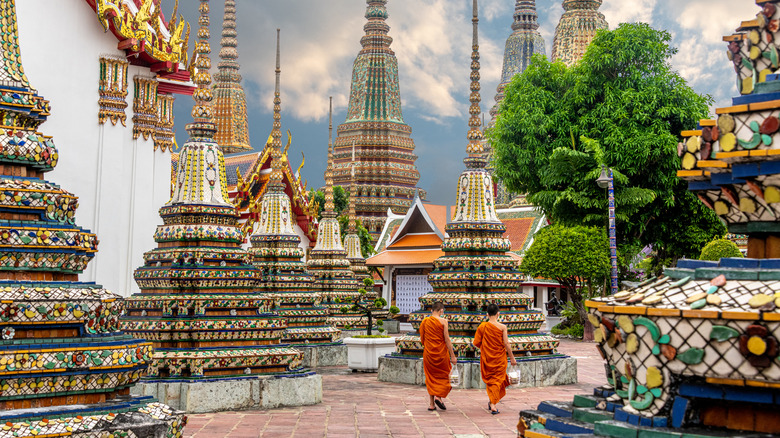Why Tourists Need To Be Cautious Of The Clothing They Pack On A Trip To Thailand
You've secured your plane ticket to visit Thailand — a country renowned for its breathtaking landscapes, vibrant culture, and spiritual heritage. It attracts nearly 30 million tourists each year. With an average temperature of 84 to 97 degrees Fahrenheit during the dry season (generally considered the best time to visit), you may think all you need to pack is some tank tops, dresses, and shorts.
However, while its beaches, markets, and cuisine are major highlights, another aspect of Thailand's appeal lies in its Buddhist temples (over 40,000 of them). They offer a glimpse into the country's soul, providing a sacred space for reflection and learning about Buddhism. When packing for a trip to the Land of Smiles, tourists often overlook a crucial item: temple attire.
Theravada Buddhism is the national religion of Thailand, practiced by over 95% of the country's 71 million population. Moreover, every Thai man under the age of 20 must serve as a monk for a period of time — whether for a few days, weeks, or months. 300,000 monks, recognizable by the dress of orange, yellow, and sometimes dark red robes, reside in Thailand.
Thai temples, or "wats," are considered holy grounds where modesty and respect are paramount. The dress code is a requirement for entry, not a suggestion — this code is rooted in the Buddhist principle of modesty and respect for sacred spaces. For tourists, failing to comply can result in being denied entry, which can disrupt travel plans and signify a lack of respect for Thai culture and religion.
What constitutes appropriate temple attire?
Understanding what to wear is essential for any tourist planning to visit Thai temples, which are some of the most beautiful temples in the world. Appropriate attire typically includes clothing that covers the shoulders and knees for both men and women — no sleeveless tops, tank tops, short skirts, or shorts. Clothes should be conservative, not see-through or tight-fitting. Avoid flashy accessories or makeup. Shoes and hats must be removed upon entering temples, either put away in a designated area or held on your person.
For women, a long skirt or dress that covers the knees and a blouse that covers the shoulders is suitable. Men should wear long pants and a shirt with sleeves. Some temples provide visitors with cover-ups or sarongs to wear over their clothes if they are deemed inappropriate, but relying on this provision is not advisable, as it may not be available at every temple. Sarongs are lightweight and can easily be stored away or pulled out if need be, so it's best to bring your own.
To avoid any inconvenience, tourists should plan their attire carefully when packing for Thailand. Including lightweight, covering tops and bottoms in your luggage ensures you're prepared for temple visits (bonus: longer layers will also protect you from the scorching sun). Carrying a scarf or shawl is a versatile option for covering shoulders when needed. When visiting temples, avoid wearing bright orange attire, as it is generally reserved for monks.
Dress codes for different types of temples
Researching the specific temples you plan to visit can also provide insights into their dress code requirements, as some might have stricter rules. For example, the Grand Palace in Bangkok is considered one of the strictest. Men and women must wear bottoms that cover all the way down to the ankles and tops that cover the upper arms. Bangkok's Wat Phra Kaew (Temple of the Emerald Buddha) has equally strict rules — it's also one of the most visited and most sacred temples in Thailand.
Island temples, such as those in Koh Samui or Phuket, deserve equal respect. Thailand also has many ruins that date back to important historical periods. Wat Chaiwatthanaram in Ayutthaya, Wat Umong in Chiang Mai, and the Sukhothai Historical Park, among other places, all fall under the category of holy ruins and deserve the same level of respect as "official" temples. In a nutshell, having your knees and shoulders covered for all sacred sites in Thailand is the bare minimum.
Ignoring the dress code can be seen as an act of disrespect towards Buddhism, the monks, and the local community. Plus, you'll be turned away at the gate. Avoidable incidents like this contribute to a negative perception of tourists and lead to uncomfortable situations for both visitors and temple authorities. Respectful tourists who follow the dress code for temple visits are rewarded with a much richer travel experience. Travel mindfully and ensure a culturally sensitive visit to Thailand's Buddhist temples by packing appropriately.


